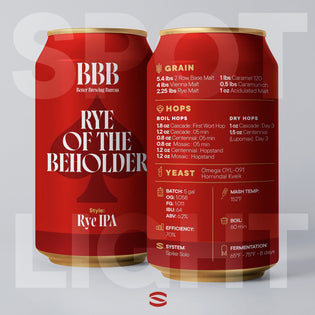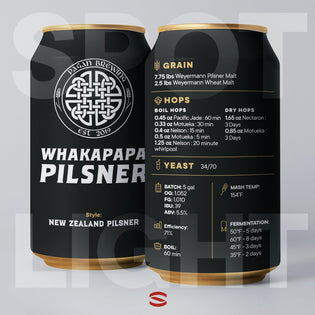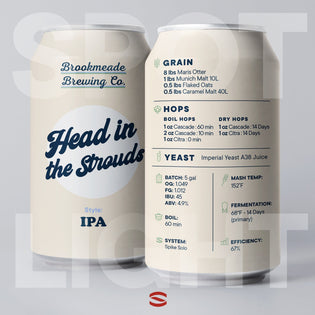
The Brewer: Dice Gods Brewing
Hey, I’m Nick! I got into brewing back in December of 2019, on more of a whim than anything else. I had a passing interest in beer brewing (and loved drinking it, going to Beerfests, etc) and got a very old kit from a co-worker. It went terribly. I didn't bottle properly, and it was a mess with bottle bombs and sediment, but I was determined.
I got a proper starter kit for Christmas from my local homebrew store, @perfect_brewsupply. I brewed one bottled batch (marginally more successful) and quickly switched to kegging right before the pandemic hit. Brewed a TON during lockdown, and the rest is history!
After brewing on my Spike custom kettle a few times, I loved it but wanted to add a few additional ports to allow me to add a pump for mash re-circulation and whirlpooling, as well as a port for a future electric element. I was pleasantly surprised that Spike would take back my old Spike OG kettle and add the additional TC ports for me, rather than making me buy a whole new kettle! Very convenient!

The Beer: Berliner Weisse
The grains are a traditional Berliner Weisse grain bill of 50% pilsner and 50% wheat, giving it a neutral flavor before adding the raspberries.
The Citra dry hops are optional, but the citrus and fruit notes from the hops complement the raspberry quite nicely!

The Recipe: Social Distance Sour

INGREDIENTS
GRAIN
- 3.5 lbs Pilsner Malt
- 3.5 lbs Wheat Malt
- 6 lbs Raspberries
- 1 lbs Lactose
HOPS
- Boil hops: 0.5 oz Hallertau Mittelfrueh - 0:15 min
- Boil hops: 0.5 oz Saaz - 0:05 min
- Dry hops: 1.5 oz Citra - 5 days
YEAST
- US-05, OYL-605 for Lacto

INSTRUCTIONS
BATCH SIZE: 5 gal
OG: 1.034
FG: 1.006
IBU: 5
ABV: 3.7%
EFFICIENCY: 72%
MASH TEMP: 149ºF
BOIL: 15 min
FERMENTATION:
68ºF - 9 days
SYSTEM: Custom BIAB
* See Pro Tips for raspberry additions.
Pro Tips
To kettle sour, mash as normal, then drop temps to between 75-95F and pitch OYL-605.
Maintain temp between 75-95F until Ph is ~3.3-3.4 (after 36 hours I was at 3.34. The lower the sourer/tart). Boil for 15 min to kill the Lacto.
Lactose is added with 10 min left in the boil and provides a bit of sweetness and also a smoother mouthfeel.
Raspberries added in secondary. I break it down with Pectic Enzyme/Pectinaise before adding.
Cheers
Dice Gods Brewing
Spike Summarizes: All Things Berliner Weisse
What is a Berliner Weisse?
Berliner Weisse is a traditional German beer style that originated in Berlin. It is a sour wheat beer known for its tartness, light body, and high carbonation. Berliner Weisse is often enjoyed as a refreshing and thirst-quenching beverage, particularly during the summer months.
What distinguishes Berliner Weisse from other beers?
Berliner Weisse stands out from other beer styles due to its unique characteristics and brewing techniques.
Sourness and Acidity
One of the defining features of Berliner Weisse is its pronounced sourness and acidity. This sourness is achieved through a process called acidification, where specific strains of bacteria, such as Lactobacillus, are used during fermentation. The result is a pleasantly tart and tangy flavor profile that sets Berliner Weisse apart from other beers.
Light and Effervescent Body
Berliner Weisse is known for its light body and high carbonation, contributing to its refreshing and lively character. The beer is typically pale in color and has a hazy appearance, showcasing its wheat content. The light body and effervescence make Berliner Weisse a highly quaffable and enjoyable beer style.
What's the history of Berliner Weisse beer?
Berliner Weisse has a fascinating history that dates back several centuries to Berlin, Germany.
Berliner Weisse is believed to have originated in the 16th or 17th century in Berlin. It was initially known as "The Champagne of the North" due to its effervescence and popularity among the upper class. The beer quickly gained prominence in Berlin and became a significant part of the city's brewing tradition.
Berliner Weisse was traditionally brewed using a combination of malted barley and wheat, giving it a distinctively grainy character. The beer was typically fermented with a mixed culture of yeast and bacteria, including strains of Saccharomyces yeast and Lactobacillus bacteria. This combination of fermentation agents contributed to the beer's sourness and complexity.
In the late 19th and early 20th centuries, Berliner Weisse faced a decline in popularity due to changing tastes and the rise of other beer styles. However, in recent years, there has been a resurgence of interest in traditional and sour beer styles, leading to a revival of Berliner Weisse.
Craft breweries around the world now produce their own interpretations of this classic style.
What does Berliner Weisse taste like?
Berliner Weisse offers a unique and complex flavor profile, characterized by its tartness and refreshing qualities.
The prominent sourness and acidity of Berliner Weisse are its defining features. The tartness can range from moderately sour to intensely acidic, depending on the specific brewing techniques and fermentation processes used. The acidity provides a sharp and tangy flavor that stimulates the taste buds.
Underneath the tartness, Berliner Weisse exhibits a delicate wheat and grain character. The wheat contributes a soft and smooth mouthfeel, while the grainy flavors provide a subtle background to the overall taste profile. These elements add depth and complexity to the beer.
Berliner Weisse often showcases subtle fruitiness, which can vary depending on the specific ingredients or additional flavorings used during brewing. Common fruit additions include raspberries, peaches, or woodruff syrup, which complement the beer's tartness and add a touch of sweetness and aroma.
Despite its sourness, Berliner Weisse finishes with a crisp and dry sensation. The combination of high carbonation, light body, and tart flavors creates a refreshing and palate-cleansing experience.
How is Berliner Weisse beer made?
The brewing process of Berliner Weisse involves specific techniques to achieve its sour and refreshing characteristics.
Souring Process
One of the key steps in brewing Berliner Weisse is the souring process. After the initial brewing, the wort (unfermented beer) is exposed to Lactobacillus bacteria, which produce lactic acid. This process acidifies the beer and creates the desired tartness. The souring process can occur either in the primary fermentation vessel or through a separate kettle souring method.
Wheat and Barley Malt
Berliner Weisse is traditionally brewed with a combination of wheat and barley malt. The proportion of wheat to barley can vary, but a significant portion of wheat is used to contribute to the beer's light body and characteristic grainy flavors. The malted grains are mashed with hot water to extract sugars and enzymes for fermentation.
Short Boiling Time
The boiling time for Berliner Weisse is usually shorter compared to other beer styles. A short boil helps preserve the delicate wheat flavors and prevents excessive caramelization or hop bitterness. Hops are typically added in minimal amounts to provide a slight balancing bitterness without overpowering the beer's sourness.
Fermentation and Carbonation
After the wort is prepared, it undergoes fermentation with a combination of Saccharomyces yeast and Lactobacillus bacteria. The specific strains used can vary depending on the brewer's preference. The fermentation process can take several days to several weeks, during which the sourness develops. Berliner Weisse is often highly carbonated, either through natural carbonation or forced carbonation.
What are the essential ingredients in Berliner Weisse?
Berliner Weisse is brewed using a few essential ingredients that contribute to its unique flavor profile.
Malted Barley and Wheat
The foundation of Berliner Weisse lies in the combination of malted barley and wheat. The specific proportions can vary, but wheat plays a significant role in the beer's light body, grainy character, and smooth mouthfeel. Barley provides additional malt sweetness and fermentable sugars for the brewing process.
Water
Water is a vital ingredient in Berliner Weisse, as it forms the base for the entire brewing process. The mineral composition of the water can influence the beer's character, affecting factors such as pH levels and yeast activity. Historically, Berlin's water had a unique mineral profile that contributed to the city's traditional Berliner Weisse.
Yeast and Bacteria
Berliner Weisse relies on a combination of Saccharomyces yeast and Lactobacillus bacteria for fermentation. Saccharomyces yeast converts sugars into alcohol, while Lactobacillus bacteria produce lactic acid, which contributes to the beer's tartness. The specific strains used can vary, but they are essential for achieving the distinct sour flavors of Berliner Weisse.
Optional Flavor Additions
While not essential to the style, some Berliner Weisse variations incorporate additional ingredients to enhance the beer's complexity and flavor profile. This can include fruit additions such as raspberries or peaches, or the use of woodruff syrup for a touch of sweetness and herbal notes. These additions add a layer of complexity and customization to the base Berliner Weisse.
What foods go best with Berliner Weisse?
Berliner Weisse's tartness and refreshing qualities make it an excellent accompaniment to a variety of foods, particularly those that can complement or contrast its flavor profile.
Fresh Salads and Light Appetizers
Berliner Weisse pairs well with fresh salads and light appetizers. The beer's crisp acidity can cut through the richness of dressings or cheeses, while its light body and refreshing qualities provide a cleansing effect on the palate. Consider pairing Berliner Weisse with salads featuring goat cheese, citrus fruits, or vinaigrette dressings.
Seafood and Shellfish
The tartness of Berliner Weisse works wonderfully with seafood and shellfish dishes. The beer's acidity can complement the natural sweetness of seafood and provide a pleasant contrast to richer or buttery preparations. Oysters, shrimp, ceviche, or grilled fish can all be excellent choices when enjoying Berliner Weisse.
Spicy and Tangy Foods
The tart and refreshing qualities of Berliner Weisse can help balance the heat and intensity of spicy and tangy foods. The beer's acidity can provide a cooling effect and cleanse the palate. Try pairing Berliner Weisse with spicy Thai or Indian curries, tangy barbecue sauces, or hot wings for a delightful contrast of flavors.
Soft and Creamy Cheeses
The tangy and acidic profile of Berliner Weisse pairs well with soft and creamy cheeses. The beer's tartness can cut through the richness of the cheeses and provide a refreshing balance. Consider enjoying Berliner Weisse with brie, camembert, goat cheese, or fresh mozzarella for a delightful combination.
Light Desserts
Berliner Weisse's tartness makes it an intriguing choice for pairing with light desserts. The beer's acidity can complement fruity or citrus-based desserts and add a refreshing element to the overall experience. Opt for desserts like lemon tarts, fruit sorbets, or lightly sweetened berry dishes to enjoy alongside Berliner Weisse.
Is Berliner Weisse a year-round beer?
Berliner Weisse is indeed a year-round beer, but its popularity tends to peak during the warmer months due to its refreshing and thirst-quenching qualities. It is commonly enjoyed as a summer beer or on hot days when a crisp and tart beer is particularly appealing. However, Berliner Weisse can be enjoyed at any time of the year, depending on personal preference and availability.
How strong is a typical Berliner Weisse?
Berliner Weisse is known for its light and sessionable nature. It is generally lower in alcohol content compared to other beer styles, making it a great choice for those seeking a more moderate drinking experience. The alcohol by volume (ABV) of Berliner Weisse typically ranges between 3% and 5%. This lower alcohol content contributes to the beer's refreshing and easy-drinking nature.
Are there different variations or flavors of Berliner Weisse?
Yes, there are various variations and flavors of Berliner Weisse available. While the classic Berliner Weisse is known for its tartness and refreshing qualities, breweries often experiment with additional ingredients to create unique flavor profiles. Some common variations include:
Fruit Berliner Weisse
Many brewers add fruits such as raspberries, peaches, or cherries to Berliner Weisse during fermentation or as a post-fermentation addition. This infusion of fruit adds additional flavors, aromas, and sometimes a touch of sweetness to the beer. Fruit variations can range from subtly fruity to more pronounced and vibrant.
Dry-Hopped Berliner Weisse
Some brewers dry-hop Berliner Weisse, adding a layer of hop aroma and flavor to the beer. This variation can result in a more complex and aromatic profile, with hoppy notes complementing the tartness of the base beer.
Barrel-Aged Berliner Weisse
Barrel-aged Berliner Weisse refers to the practice of aging the beer in oak barrels, often previously used for wine or spirits. This process can impart unique flavors and characteristics to the beer, such as oak, vanilla, or subtle funkiness from wild yeast or bacteria present in the barrel.
These variations provide an opportunity for brewers to showcase their creativity and offer diverse experiences within the Berliner Weisse style. Keep in mind that availability may vary depending on the brewery and location.
What glassware is typically used for serving Berliner Weisse?
Berliner Weisse is often served in a specific type of glassware that enhances its appearance and aromatic qualities.
Berliner Weisse Glass
The Berliner Weisse glass is a tall, narrow, vase-shaped glass with a stem. It is specifically designed to showcase the beer's appearance and retain the aroma. The shape of the glass helps concentrate the aromas towards the nose, allowing the drinker to fully appreciate the nuances of the beer. The narrow opening also helps retain carbonation.
Goblet or Tulip Glass
If a Berliner Weisse glass is not available, a goblet or tulip-shaped glass can be used as an alternative. These glasses offer a similar effect, allowing the beer's aromas to be captured and providing an enjoyable drinking experience.
The choice of glassware may vary depending on personal preference and availability. The key is to use a glass that allows you to appreciate the beer's visual appeal and capture its aroma.
Is Berliner Weisse a good beer style for beginners?
Berliner Weisse can be an acquired taste due to its tartness and acidity. While it may not be the first beer style beginners gravitate towards, it can certainly be appreciated by those who enjoy sour and tangy flavors. The light body, refreshing qualities, and lower alcohol content also make it approachable for new beer drinkers.
If you're new to sour beers or have a preference for milder flavors, you might find Berliner Weisse to be a bit more challenging. However, if you have an adventurous palate and enjoy exploring different taste profiles, Berliner Weisse can be an exciting introduction to the world of sour and tart beers.
How does Berliner Weisse differ from other sour beer styles?
Berliner Weisse has its unique characteristics that distinguish it from other sour beer styles.
Lactic Acid Fermentation
One of the primary differences lies in the fermentation process. Berliner Weisse undergoes lactic acid fermentation, where specific strains of bacteria, such as Lactobacillus, produce lactic acid, giving the beer its tartness. Other sour beer styles, such as Gose or Flanders Red Ale, may use different bacteria or wild yeasts for fermentation, resulting in varying levels of acidity and flavor complexity.
Light Body and Refreshing Nature
Berliner Weisse is known for its light body and refreshing qualities. It is typically lower in alcohol content and has high carbonation, contributing to its easy-drinking nature. Other sour beer styles may have different body profiles, ranging from medium-bodied to fuller-bodied, depending on the brewing techniques and ingredients used.
Tartness and Acidity Levels
While all sour beers exhibit varying levels of tartness and acidity, Berliner Weisse is often characterized by a more pronounced and crisp tartness. The lactic acid produced during fermentation gives Berliner Weisse its distinctively tangy and sharp flavor profile. Other sour beer styles may have varying degrees of acidity, with some leaning towards complex fruity or funky flavors.
Traditions and Regional Identity
Berliner Weisse has a rich history and strong association with Berlin, Germany. It is deeply rooted in the city's brewing traditions and holds cultural significance. Other sour beer styles, such as Belgian Lambic or American Wild Ales, have their own unique traditions and regional identities, reflecting the brewing practices and ingredients specific to their respective regions.
While all sour beer styles share the common characteristic of acidity, Berliner Weisse's light body, high carbonation, pronounced tartness, and regional identity set it apart from other sour beer styles.
Where can I buy Berliner Weisse beers?
Berliner Weisse beers can be found in various locations, including bottle shops, craft beer bars, and online retailers. Here are some places where you can explore and purchase Berliner Weisse beers:
Local Bottle Shops and Craft Beer Retailers
Check your local bottle shops or craft beer retailers that specialize in carrying a wide selection of craft beers. These stores often have a dedicated sour beer section where you can find Berliner Weisse offerings. The staff at these establishments can also provide recommendations and insights into different Berliner Weisse brands and variations.
Craft Beer Bars and Breweries
Visit craft beer bars and breweries in your area that feature a rotating tap list or bottle selection. Many craft beer-focused establishments will have Berliner Weisse available, either as a regular offering or as part of special releases. This allows you to sample a variety of Berliner Weisse styles and brands on-site.
Online Beer Retailers
Several online beer retailers offer a wide range of craft beers, including Berliner Weisse. These retailers often ship to various locations, allowing you to order Berliner Weisse beers from the comfort of your home. Check for reputable online beer shops that specialize in craft beer and offer a diverse selection of sour beers.
Directly from Breweries
Some breweries that produce Berliner Weisse beers may offer direct-to-consumer sales through their websites. This gives you the opportunity to purchase Berliner Weisse directly from the source, ensuring freshness and access to limited releases or brewery-exclusive variations.





